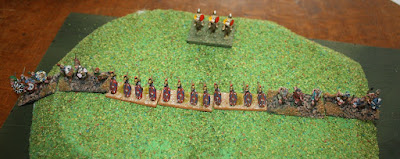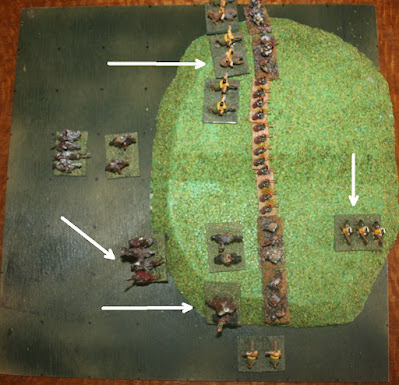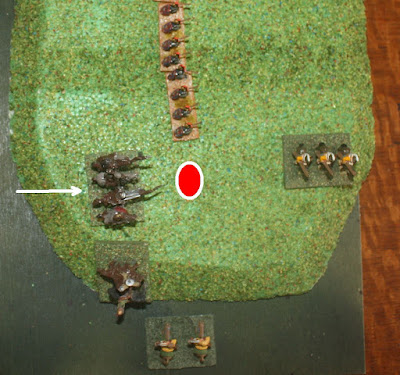Introduction
This was going to be game 63 in testing my Ancient
Battlelines Clash rules. I have been going through lots of design changes over
the last few years with these rules and I think I have finally got to the stage
where, after 10 years of enjoyment with them, they are not meeting my needs any
more. The main one is that I find I want
to play ancients games without markers!
I think this is more of a “I like to set it up and play easily and
markers get in the way” rather than not liking markers 😊. I went back and looked at my ABC rules with
markers and other rules. After much
vacillation, I played a few test games with Phil Sabin’s Phalanx and after
reorganising the combat modifiers to be based on the defending unit I found
them quite easy to use. I deploy the
units for battle rather than use the Phalanx deploy from camp, and use an 8x8 squared
grid. But still 90% Phalanx rules.
Why not DBA/DBM? I find that I am not fond of recoils as a main combat result. And recoils are a critical cog in the Dbx rules – without recoil you do not get command and control impacts, combat advantage/disadvantage, movement restrictions etc.
Note I am using my 15mm figures on an 8x8 grid with 43cmx43cm squares (squares just a bit larger thna the 40mm wide bases).
Battle of Taurus aka Cilician Gates
The Parthians invade Syria alongside the Rebel Roman Labienus taking Asia Manor. Antony sends Venudinus to stop them and takes up a defensive position on a hill as the Parthians, eager to attack, do not wait for Labienus forces to assist.
Troops
Roman
 |
| Romans - the light infantry on the flanks |
3 HI (Heavy Infantry)
4 LI (Light Infantry)
1 MC (Medium Cavalry)
Parthian
 |
| Parthians. Cataphracts at the rear |
2 CAT (Cataphracts)
7 LC (Light Cavalry)
Scenario changes
Reduced the number of figures.
The Parthians must attack with their Light cavalry uphill on the first turn.
Deployment
 |
| Deployment - Parthians on the left, Romans on the right |
The Parthians need to get 3 units onto a Roman LI unit to rout it due to them being uphill and in difficult terrain. It will not be easy. The Romans need to sit there and do local counter-attacks but not subject themselves to being surrounded. And don’t leave the hill!
Phalanx is all about getting a certain number of units able to attack an enemy unit. It is then routed. 3 units Vs infantry, Elephants and Chariots, 2 Vs everyone else. There are situational modifiers tha my increase or decrease the number of attacking units required.
Game
Parthians advance on both flanks
 |
| Parthians advance |
They contact the Roman light infantry and rout one on each side.
The Romans retaliate and rout two light cavalry units
 |
| Two light cavalry units following two Roman LI routed |
The General Cataphract advances up the hill to assist in routing another Light infantry.
 |
| The General helps rout another Light infantry |
The Romans keep getting one command roll and so their Cavalry barely moves. They do manage to rout another rlight cavalry on their right flank.
 |
| Romans rout another unit on their right flank |
The Parthians see an opening to take out a legionary unit. Thy have got the numbers but roll a 1 meaning they need one more unit that they don’t have. Unliucky!
 |
| Parthians attempt to rout a legionary unit |
The Romans fnally manage to get there cavalry (with general) into the action and rout another unit. The Parthians have reached their breakpoint (4 units) but victory is decided by losses at the end of your own turn.
 |
| The Roman cavalry enters the fray |
The Parthians destroy a legionary unit on their right flank. The Parthians having reached their breakpoint flee. The Romans have not suffered more units lost (both have lost 4) else the game would have continued unit one side had lost more than the other.
 |
| The Parthians destroy a legionary unit but it is not enough and they flee. |
Checking losses gives the Romans a Narrow Victory.
Verdict
In Phalanx you can normally activate three groups of units,
I have made it two due to less units. On
a roll of a 1 at the start of the turn you reduce the number of groups that can
be activated by 1. I rolled a lot of 1s
for both sides in this game.
I also realised I missed some of the modifiers that would
have helped the Romans and it should have been harder for the Parthian light
cavalry to clear the light infantry from the hills. Ah well; more games will get me more familiar
with them.
The game did not last very long but was very
interesting. Not many dice rolls as the
game is about concentration of force while minimising your own exposure. There are nuances I had not realised until
playing such as the victory conditions (checking at the end of your own turn
gives a chance for a side to inflict more casualties and stay in the game). I am liking them for a broad brush
approach to large battles. They are very chess-like and I think for solo I need more chaos. I am creating some rules based loosely on Phalanx as I post :-)


























































.jpg)




A new baby grows🙂 this would make an ideal set to take on vacations.
ReplyDeleteI played a variant of these rules earlier this year when I went on holidays (using 6mm figures on a 30cmx30cm board.). I was actually thinking only this morning that hopefully the revised verison becomes a great set to take on holidays :-)
DeleteIs Phalanx still available anywhere? They do indeed sound very interesting and I usually enjoy Phil Sabins rules.
ReplyDeleteI went looking last year and could not find a copy anywhere. There is a cutdown version (just hoplites) that used to be in the Lost Battles Yahoo Group but is not in the IO Group. The original (and complete) rules for Phalanx is spead out over about 6 Slingshot articles in the 90s. That is what I am using.
DeleteHi Martin, I have Phalanx available as a PDF somewhere, I think. I'll dig it out and send you a copy. If you have the SOA cd or dvd, "5000 years of Slingshot", it's definitely in there as it was first published as an article on Slingshot a very long time ago. It's an innovative game and I particularly liked the "deploy from the camp" mechanism, as it adds a degree of pre-battle jockeying for position that's markedly more effective than the usual methods. I occasionally use it for DBA games. Regards, Chris
DeleteI've just noticed that my comment was anonymous so you've no flipping idea who Chris is! Well now you do, of you're bothered.
DeleteSounds good so far.
ReplyDeleteI love the small battlefield - perfect for quick games or where space is limited (such as when away on holidays etc 👍😎).
I agree about the need for chaos - in the heat of battle, particularly ancient battles, there’s rarely such a thing as a guarantee. Apart from that you can be sure something, somehow, somewhere is bound to go awry.
Cheers,
Geoff 😉
Thanks Geoff. I am so used to playing on 2'x2' but finding the smaller battlefield ever better :-) I need more chaos (randomness) in the game to help me play solo!
DeleteThat's a neat reinvention of Phalanx, Shaun. I've had a soft spot for the game for a long time. I started taking a copy on holiday when my son was old enough to play and we ran a holiday Phalanx league for years. We're must have played about fifty hairs and it was a pretty even set of results.
ReplyDeleteWe're = we and hairs (hairs? really?) = games :-|
DeleteHello Chris,
DeletePhalanx is a great set of rules and full of tactical decisions. But after a few games I found it is not the most solo friendly set - I feel a bit like I am playing chess solo. i have gone back to an older ruleset (Rally Round the King) as a basis that suits me better for solo playing.